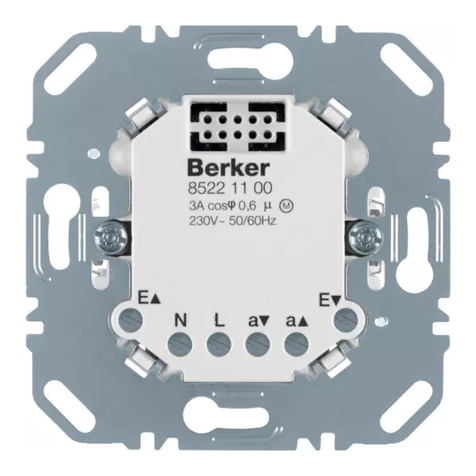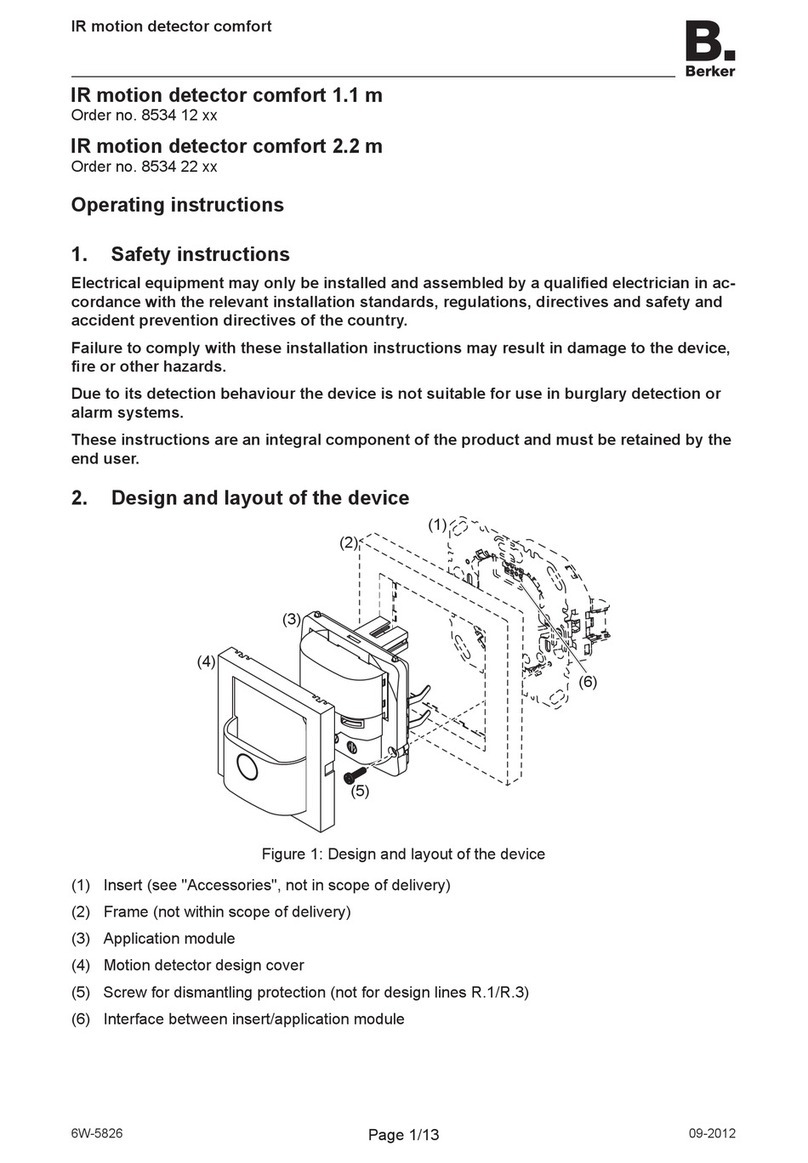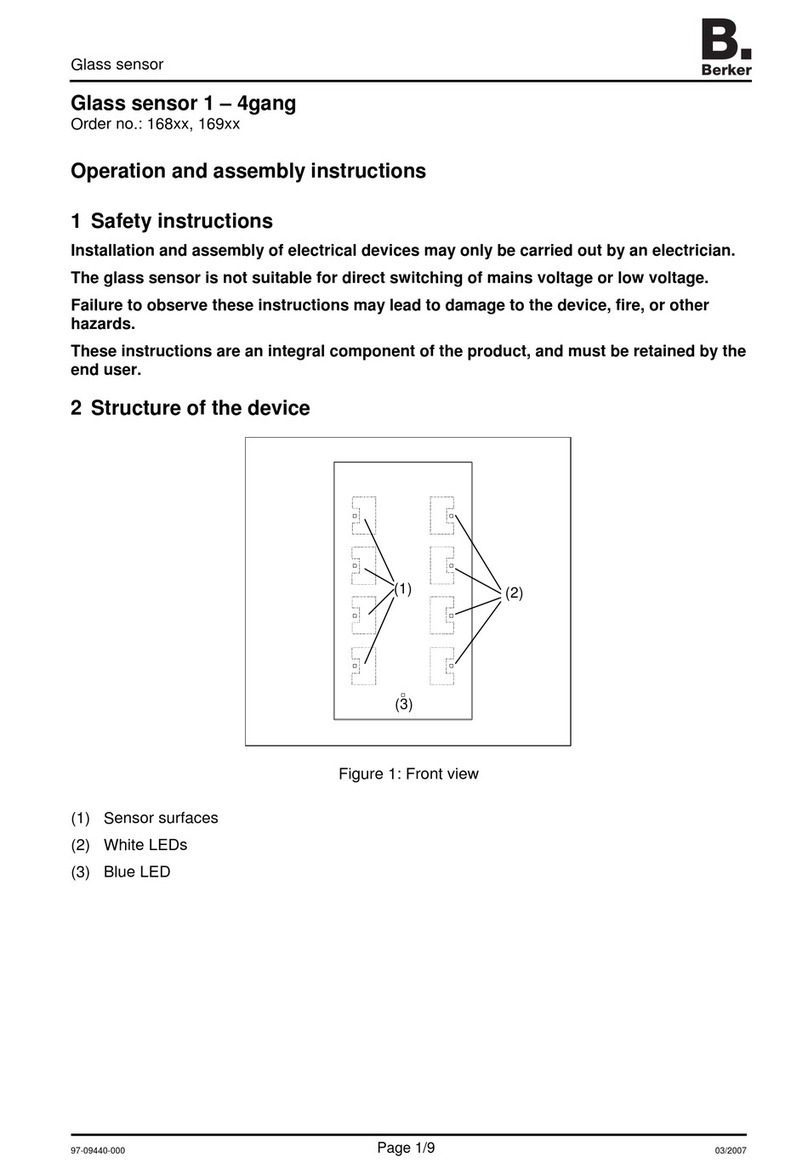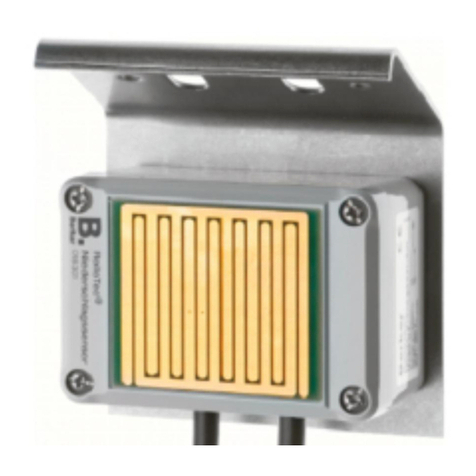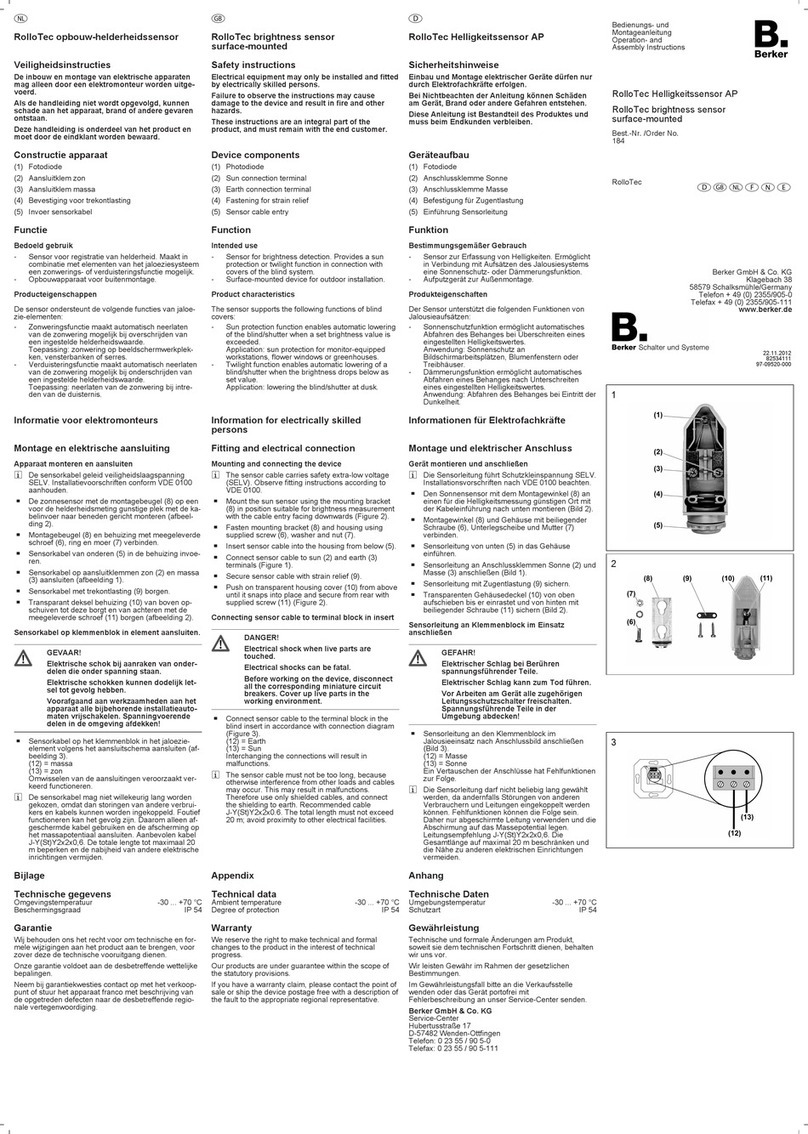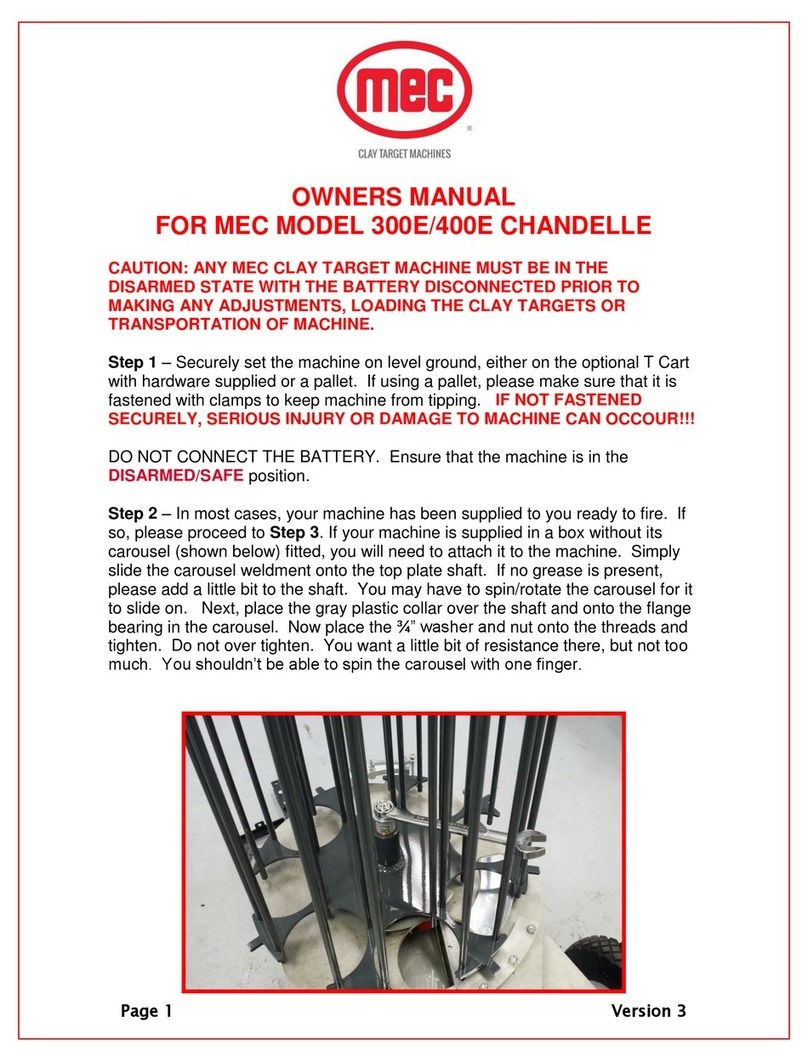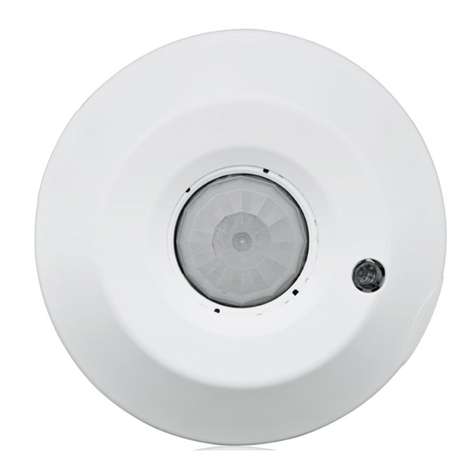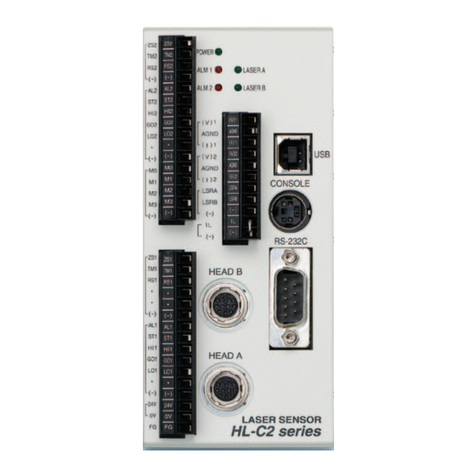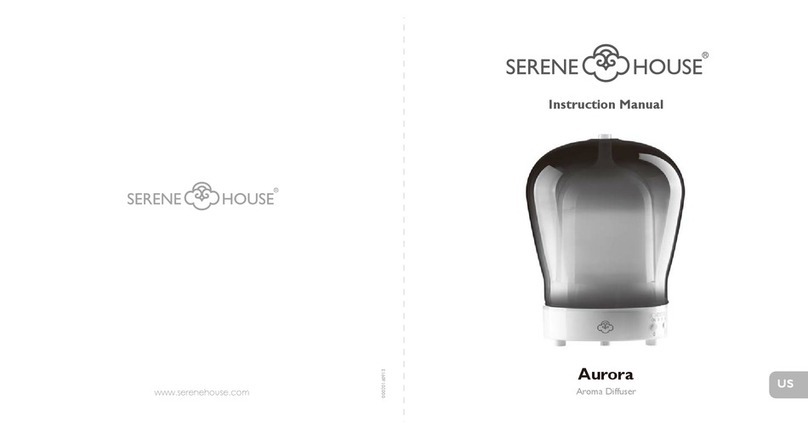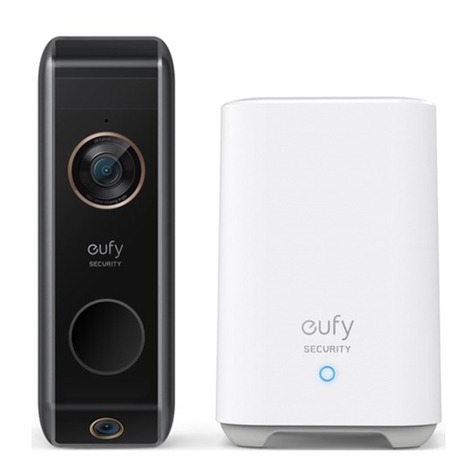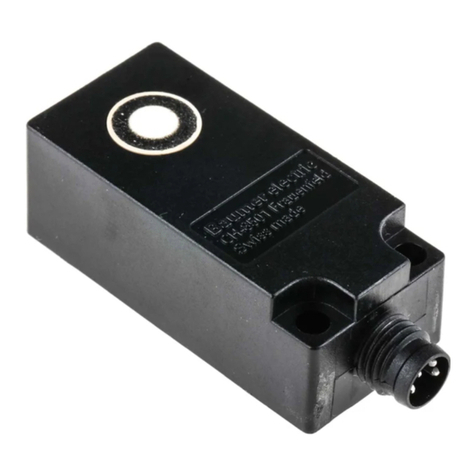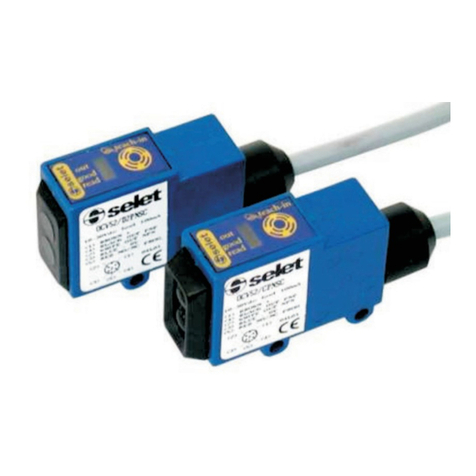Berker 8534 51 series User manual

Radio motion detector comfort 1.1 m/2.2 m quicklink
Page 1/18
6W-5827 09-2012
Radio motion detector comfort 1.1 m/2.2 m quicklink
Order number 8534 51 ..
Operating instructions
1. Safety instructions
Electrical equipment may only be installed and assembled by a qualied electrician in ac-
cordance with the relevant installation standards, regulations, directives and safety and
accident prevention directives of the country.
Failure to comply with these instructions may result in damage to the device, re or other
hazards.
The radio transmission is not suitable for safety or alarm applications.
Due to its detection behaviour the device is not suitable for use in burglary detection or
alarm systems.
These instructions are an integral component of the product and must be retained by the
end user.
2. Design and layout of the device
(3)
(4)
(5)
(2)
(1)
(6)
Figure 1: Design and layout of the device
(1) Insert (see "Accessories", not in scope of delivery)
(2) Frame (not within scope of delivery)
(3) Application module
(4) Motion detector design cover
(5) Screw for dismantling protection (not for design lines R.1/R.3)
(6) Interface between insert/application module

Radio motion detector comfort 1.1 m/2.2 m quicklink
Page 2/18
6W-5827 09-2012
3. Function
System information
This device is a product of the quicklink system, in which installation devices communicate via
radio signals.
Quicklink stands for a conguration mode in which the function-related connection between
transmitters and receivers is set on the device through buttons and displays without further
tools.
All devices congurable by quicklink can be operated together in one system.
Correct use
–Automatic switching of lighting depending on heat motion and ambient brightness
–Application module for switch insert, ush-mounted dimmer or power supply for radio
application modules
–The device has been laid out for smaller applications in which a maximum of 20 devices
are allocated
–Only suitable for use in indoor areas with no drip and no spray water
Product characteristics
–quicklink functions to extend the detection area, scenes, control circuits
–remote control via quicklink transmitter
–Integrated button for selecting operating modes and special functions
–Lockable integrated button
–Operating modes - automatic mode, permanent ON, permanent OFF can be selected
–Display operating mode via LED
–Potentiometer for adjusting the response brightness and detection sensitivity
–Adjustable detection angle for adaptation of the detection area
–Additional adjustment of the response brightness via Teach-In function
–Party function
–Presence simulation
–Optional extension unit operation via installation button
Automatic mode
The motion detector detects heat motion caused by persons, animals, or objects.
On switch insert and ush-mounted dimmer with factory setting:
–The light will be switched on for a xed delay time of 3 minutes if movements are detected
in the detection area and the set brightness threshold is undershot. Each additional move-
ment in the detection area restarts the delay time.
–The light will be switched off after 3 minutes if no additional movements are detected.
On ush-mounted dimmer congured with time function (see radio conguration quicklink):
–The light will be switched on for the delay time, if movements are detected in the detection
area and the set brightness threshold is undershot. Each additional movement in the detec-
tion area restarts the delay time.
–After the delay time elapses the lighting will be dimmed to 50% of the switch-on brightness-
level and will remain at this brightness level for 30 s (switch-off pre-warning). Each
movement detected during the switch-off pre-warning restarts the delay time and restores
the switch-on brightness level.
–The light will be switched off if no motion is detected any longer in the detection area and
the set delay time and the switch-off time have elapsed.

Radio motion detector comfort 1.1 m/2.2 m quicklink
Page 3/18
6W-5827 09-2012
Performance after mains breakdown/return of mains supply
–Mains breakdown shorter than 0.2 s:
The function is not impaired.
–Mains breakdown longer than 0.2 s:
There is no function during the mains breakdown. The current conguration is saved in
non-volatile memory.
–Return of mains supply:
The application module executes an initialisation for approx. 5 s, during which the lighting
will be switched on. Motion detection starts thereafter. If no motion is detected during the
rst 5 s, the lighting is switched off. The saved conguration is loaded from memory. During
this period local operation via the button or extension unit can be used.
4. Operation
Operating concept
(8)
(7)
Fig. 2: Operating and display elements
(7) Button
(8) Status LED
Operation is executed by pushing the button (7) on the motion detector:
–A short press of the button switches the operating modes. The operating mode is displayed
via the status LED behind the optics cover of the motion detector.
–Keeping the button pressed activates special functions. Selection of the special functions is
supported by the LED display (Fig. 3).
Function Party function Teach-In Keylock Presence
simulation
Load setting
mode1)
LED display
Hold time
operation
button
> 5 s > 10 s > 15 s > 20 s > 25 s
1) Only on universal switch insert and universal ush-mounted dimmer
Fig. 3: Selection of the special functions and LED display

Radio motion detector comfort 1.1 m/2.2 m quicklink
Page 4/18
6W-5827 09-2012
Selecting the operating mode
Briey press the button repeatedly until the desired operating mode is selected.
The status LED indicates the selected operating mode (see Table 1).
Switching the operating mode nishes the party function or presence simulation, if these
functions were previously active.
LED display Operating
mode
Description
-- Auto Motion-dependent and brightness-dependent switch on/
switch off of the load
green Permanent
ON
Load is permanently switched-on/switched-off.
Extension unit signals, as well as radio signals, will not be
evaluated
red Permanent
OFF
Table 1: Display of operating modes
Disabling/enabling operating mode selection via button
Keep the button pressed for more than 15 seconds, until the status LED is ashing green
(Fig. 3).
Selection of the operating mode via the button is disabled.
or if the button is locked:
Keep the button pressed for more than 15 seconds, until the status LED is ashing green
(Fig. 3).
Selection of the operating mode via the button is possible again.
Switch on the lighting via push-button extension unit or change the switch-on bright-
ness-level
Optionally the lighting can be switched on via a mechanical push-button extension unit.
For extension unit operation, the lighting is switched on independently of the set brightness
threshold.
When using the ush-mounted dimmers, the last set brightness level will be saved as the
switch-on brightness-level.

Radio motion detector comfort 1.1 m/2.2 m quicklink
Page 5/18
6W-5827 09-2012
Dimming status Operation button Performance of the insert
Motion detector applied on switch insert
OFF Short press Load is switched on for the set delay time
ON Short press Extension of switch-on time by the set delay time
Motion detector applied on ush-mounted dimmer
OFF Short press Load is switched on to the switch-on brightness-
level for the set delay time
ON Short press Extension of switch-on time by the set delay time
at the same brightness
OFF Long press Load is switched on to switch-on brightness-
level, subsequent dimming in the opposite
direction of the last dimming process. Thereafter
the load remains switched on for the delay time
ON Long press Changes the current brightness. Dimming
takes place in the opposite direction of the last
dimming operation until maximum or minimum
brightness. Subsequently the load remains
switched on at the set brightness for the set
delay time
Table 2: Operation via push-button extension unit
Activating/interrupting party function
The party function switches the lighting on for 2 hours. During this time no extension unit or ra-
dio commands are executed.
Keep the button pressed for more than 5 seconds, until the status LED is ashing red (Fig.
3).
The lighting is switched on for 2 hours. During this time the status LED is ashing red.
Upon elapse of 2 hours, the motion detector switches to Auto operation mode.
Briey press the button.
The party function will be interrupted, the motion detector returns to Auto mode.
Setting response brightness via Teach-In function
The response brightness is the brightness value saved in the motion detector; when this value
is undershot the motion detector switches the connected load if movements are detected. Via
Teach-In function the current ambient brightness is saved as the response brightness.
The load is switched off.
Keep the button pressed for more than 10 seconds, until the status LED is ashing orange
(Fig. 3).
The motion detector detects the current ambient brightness and saves it as response
brightness.
Setting of the response brightness via Teach-In function and via the brightness potentiome-
ter has the same priority. Teach-In overwrites the response brightness set on the brightness
potentiometer. If the setting is made again via the potentiometer the Teach-In gure will be
overwritten.

Radio motion detector comfort 1.1 m/2.2 m quicklink
Page 6/18
6W-5827 09-2012
Activating/deactivating presence simulation
During operation, the motion detector counts the motion detections in one full hour and saves
the result. With active presence simulation at the beginning of the hour with the most detections
saved, the light will be switched on for the duration of the delay time, even no motion is detec-
ted.
During the presence simulation presence detection, extension unit and radio commands will
continue to be executed normally.
Keep the button pressed for more than 20 seconds, until the status LED is slowly ashing
red (Fig. 3).
The presence simulation is active. During this time the status LED lights orange. The moti-
on detector switches the lighting on at the saved time.
Briey press the button.
The presence simulation will be disabled, the motion detector returns to Auto mode.
Setting the load
If the dimming and switching performance of loads is unsatisfactory after start-up, especially
when circuited to energy-saving lamps and 230 V LED lamps, a load setting must be carried out
for universal switch inserts or universal touch dimmers.
Switch off load.
Keep the button pressed for more than 25 seconds, until the status LED is slowly ashing
orange.
The connected load blinks once. The device is in selection mode.
If there is no further operation within the next 10 seconds, the insert swiches to switching/
dimming operation.
Briey press the button repeatedly to activate the desired setting mode (Table 3).
The load setting is executed.
Briey
press the
button
Setting mode Conrmation of the
load setting Notes
1 x Load ne-setting Load blinks 1 x after
approx. 30 s and changes
to switching/dimming ope-
ration
Not suitable for ohmic loads (e.g. incandescent,
HV halogen lamps); use factory load setting.
If the load ne-setting does not bring any impro-
vement for energy-saving lamps or 230 V LED
lamps, select the energy-saving lamp ne-setting
or 230 V LED lamp universal setting.
2 x Factory load setting Load blinks 2 x after
approx. 6 s and changes
to switching/dimming ope-
ration
3 x Energy-saving lamp
ne-setting in phase
cut-on
Load blinks 3 x after
approx. 30 s and changes
to switching/dimming ope-
ration
Energy-saving lamps are switched ON at a
brightness level of at least 50% brightness in
order to ensure an ignition process.
4 x 230 V LED lamp
universal setting in
phase cut-off
Load blinks 4 x after
approx. 5 s and changes
to switching/dimming ope-
ration
The universal setting contains standard values
which enable the operation of typical dimmable
230 V LED lamps.
For all setting modes Load blinks 5 x The selected setting mode is not supported by
the insert.
Table 3: Load setting mode

Radio motion detector comfort 1.1 m/2.2 m quicklink
Page 7/18
6W-5827 09-2012
5. Information for electricians
5.1 Installation and electrical connection
Selecting installation location
A minimum distance between the transmitter and corresponding receiver of about 1 m must be
maintained.
A minimum distance to electronic devices which emit high frequency signals such as computers,
electronic transformers or microwave devices of approx. 0.5 m must be maintained.
Mounting on or close to metal surfaces may cause impairment of the radio transmission.
Take material penetration into account. The range of the system can be optimised by selecting
the best possible installation site:
Material Degree of material penetration
Wood, plaster, plasterboard, uncoated glass approx. 90 %
Brick, press boards approx. 70 %
Reinforced concrete, underoor heating approx. 30 %
Metal, metal grids, aluminium laminates,
coated glass
approx. 10 %
Rain, snow approx. 1 ... 40 %
Table 4: Material penetration
Observe the motion orientation: a distinction is made between direct approach and trans-
verse motion. Motions transverse to the motion detector can be detected better than moti-
ons toward the motion detector (Fig. 4).
Select an installation location that is free of vibration. Vibrations can cause undesired
switching.
Avoid sources of interference in the detection area. Sources of interference, e.g. heating
elements, ventilation systems, air conditioners and lamps that are cooling down can cause
undesired switching (Fig. 4).
To avoid disturbing inuences, the detection angle can be restricted (see Restriction of the
detection area).
180°
çç
1,10 m
2,2 m
Fig 4: Installation location of the motion detectors
Assembly of the device (Figure 1)
Information on electrical connection are to be taken from the operating instruction of for the
insert.
Attach the bottom part of the application module (3) together with frame (2) to a suitable
insert (1) and establish a connection between insert and the application module via the in-
terface between application and power module (6).
As soon as voltage is supplied to the application module, the status LED indicates the com-
patibility to the insert used.

Radio motion detector comfort 1.1 m/2.2 m quicklink
Page 8/18
6W-5827 09-2012
Status LED display Meaning
LED blinks green (approx.
5 s until motion detection is
active)
Compatible
LED blinks red for 5 s Not compatible.
LED blinks orange for 5 s Compatible, but not congured to each other. For a new conguration, the
application module must be reset to factory settings.
If available, x dismantling protection with screw (5).
After radio conguration and start-up, click the design cover (4) into place on the applicati-
on module (3).
5.2 Start-up
Overview of operation and adjustment elements
T
150
90°
...
45° 45°
...
90°
fct
cfg
(9)
(9)
(10)
(11)
(12)
(13)
(13)
(14)
Fig. 5: Operating and adjustment elements of the bottom part of the application module
(9) Sensitivity potentiometer
(10) fct button
(11) Detection angle adjuster
(12) Status/fct LED
(13) cfg button/LED
(14) Response brightness potentiometer

Radio motion detector comfort 1.1 m/2.2 m quicklink
Page 9/18
6W-5827 09-2012
Setting the detection area
1.75 m
1.1 m
8 m
8 m
180°
2 m 4 m 6 m 8 m 10 m
12 m
Figure 6: detection area of the motion detector for mounting height 1.1 m
2 m
6 m6 m 4 m 6 m 8 m 10 m
~ 3°
1.1 m
2.2 m
1.75 m
8 m
Figure 7: detection area of the motion detector for mounting height 2.2 m
The detection angle can be restricted for the right side and for the left side via each adjuster
(Fig. 5, 10) between 45° ... 90°. Thus the detection angle can be between 90° and 180° (Fig.
7).
Use the adjusters to set the detection angle for each side.
T
150
90°
...
45° 45°
...
90°
fct
cfg
T
150
90°
...
45° 45°
...
90°
fct
cfg
T
150
90°
...
45° 45°
...
90°
fct
cfg
T
150
90°
...
45° 45°
...
90°
fct
cfg
T
150
90°
...
45° 45°
...
90°
fct
cfg
T
150
90°
...
45° 45°
...
90°
fct
cfg
~ 180° ~ 135° ~ 90°
Fig. 7: Setting the detection angle
Setting the detection performance
Test mode must be used to test the detection performance. In test mode, the motion detector
works independent of brightness. Each detection switches the lighting and the status LED on for
3 seconds. Thereafter motion detection will be deactivated for 2 seconds.
The motion detector is connected and ready for operation.
Setting the test mode. To do so, set the response brightness potentiometer (Fig. 5, 13) to
the T position.
Leave the detection area and observe the switching behaviour.
If the motion detector switches on without motion in the detection eld, then sources of in-
terference (see Installation location) are present or the sensitivity is set too high.
Reduce the sensitivity if necessary and blank out sources of interference by adjusting the
detection angle or removing them.
Check the detection area using a detection test and adjust if necessary.
If the detection area is too small, it can be extended via motion detector extension units or
per radio via a master-slave con guration (see radio con guration).

Radio motion detector comfort 1.1 m/2.2 m quicklink
Page 10/18
6W-5827 09-2012
Setting the response brightness
The response brightness is the brightness value saved in the motion detector; when this value
is undershot the motion detector switches the connected load if movements are detected. The
response brightness can be set between approx. 5 (�) over 150 Lux to daytime operation (�).
The symbol stands for brightness-independent switching. The response brightness can be
variably adjusted in the intermediate areas.
To control the lighting in stairwells in accordance with DIN EN12464-1, 2003-3, turn the po-
tentiometer to the 150 Lux mark.
Turn the response brightness potentiometer (Fig. 5, 13) to the desired position.
To save the current ambient brightness as response brightness, use the Teach-In function
(see Setting the response brightness via Teach-In function).
Setting the sensitivity
Detection is factory-set to maximum sensitivity. If there are frequent incorrect detections, the
sensitivity can be reduced.
Turn the sensitivity potentiometer (Fig. 5, 9) to the desired position.
5.3 Radio con guration quicklink
The radio con guration sets the functional connection between commanding (transmitters) and
function-executing (receivers) radio components. Thus wireless e.g. master, group, extension
unit and time controls can be realised.
The following can be con gured:
–The local operation of the load connected to the insert
–Radio commands to control other receivers
–Functions which are executed when the radio commands are received
For con guration by means of Hager connection device TX100 or ETS, additional functions
are available (see operating instructions for TX100 or application description for ETS).
Con guration of radio motion detector as a receiver
Con guration to control the load connected to the insert via reception of a radio command.
fct LED
display
Con gurable
functions
Function resulting from transmitter operation,
Notes
On switch insert On ush-mounted dimmer
On/OFF 1)
ON/OFF,
dimming UP/DOWN
1)
Short press on push-button: Switching ON/OFF
Long press on push-button: Dimming, reverse dimming
direction per actuation
ON 1) ON,
dimming UP 1)
Short press on push-button: Switching ON
Push and hold button: Dimming UP to maximum
brightness-level
OFF 1) OFF,
dimming DOWN 1)
Short press on push-button: Switching OFF
Short press on push-button: Dimming DOWN to minimum
brightness-level
1Scene 1 1) Receiver is allocated to a scene due to the con guration
of the function.eceivers are allocated to a scene due to
the con guration of the function.
Short press on button: calling up the saved state of the
connected load for the scene
2Scene 2 1)
Timer 1) Switching ON for the set switch-on time
Factory setting 3 min
ON/OFF
(switch/push-button) 1)
Closing of the actuating contact switches the load ON,
opening of the contact switches the load OFF.

Radio motion detector comfort 1.1 m/2.2 m quicklink
Page 11/18
6W-5827 09-2012
Forced mode ON Switches the load with higher priority to the appropriate
state. Execution of other commands is only possible after
resetting the forced command.
Forced mode OFF
Presence--
simulation 1)
Activates/deactivates execution of presence simulation
(See activating/deactivating presence simulation).
Master-Slave 2)
Is used to extend the detection area. Receives switch-on
commands in case of motion detection in the detection
area of the transmitter (Slave). Switches the lighting ON
for the set delay time.
The brightness evaluation only takes place on the ma-
ster, the slave only detects motion.
Can only be con gured between radio motion detec-
tors.
Delete No function
Assignment to transmitter is deleted
1) Execution of the receiver function and local motion detector function have the same priority:
– If the transmitter was rst switched on/off and then motion was detected afterwards, then the motion detector
will override the transmitter command
– If motion was detected and thereafter during the delay time the system is switched on/off via the transmitter,
then the transmitter will override the motion detector
2) Only with radio motion detector on power supply for radio application module as transmitter
Table 5: Con gurable functions

Radio motion detector comfort 1.1 m/2.2 m quicklink
Page 12/18
6W-5827 09-2012
As an example the con guration of a wall-transmitter and a radio motion detector as receiver is
described down below.
Handling step Result
Start con guration
Short press on cfg button on the wall transmitter.
If there is no further activation, the con guration is auto-
matically ended after 10 minutes.
The cfg LEDs on the wall-transmitter and the radio
motion detector light up in red colour.
T
150
90°
...
45° 45°
...
90°
fct
cfg
All receivers within radio range also indicate the con -
guration mode.
Select transmitter button
Short press on press-activation point on the wall-
transmitter which should activate the function.
The cfg LED on the wall transmitter blinks for 1 se-
cond.
If con gured already, the fct LED of the motion detec-
tor indicates the currently con gured function.
T
150
90°
...
45° 45°
...
90°
fct
cfg
Select function at receiver
Repeated short press on fct button on the motion
detector until the desired function is displayed (Table 7).
T
150
90°
...
45° 45°
...
90°
fct
cfg
After each activation, the fct LED indicates the func-
tion.
If the transmitter button has already been con gu-
red with a function in a different receiver and/or the
con gured function is part of a group control, only
this function can be con gured. To change a func-
tion, the existing con guration must be deleted and
the new one needs to be con gured.
Con rming function on receiver
To con rm, keep the fct button pressed for more than
than 2 seconds.
T
150
90°
...
45° 45°
...
90°
fct
cfg
> 2 s
The cfg LED blinks during the saving process (ap-
prox. 5 s). The fct LED con rms the function selection
by displaying the corresponding colour.
T
150
90°
...
45° 45°
...
90°
fct
cfg
A quick blinking of the cfg LED indicates a combi-
nation that is not possible or an error.

Radio motion detector comfort 1.1 m/2.2 m quicklink
Page 13/18
6W-5827 09-2012
Finish con guration
Short press on cfg button on the wall transmitter again.
The cfg LEDs on the wall-transmitter, on the motion
detector and on all receivers within radio range go out.
The function is con gured.
Table 6: Con guration of the function for the radio motion detector
Con guration of motion detector as transmitter
If the radio motion detector is operated as a transmitter, it can support the following functions for
receivers. The speci c function can vary depending on the receivers used:
ON/OFF (delay time)
Pre-con gured command in automatic mode: Motion detection at simultaneous undershoo-
ting of the brightness threshold switches the load ON, and after the delay time elapses ac-
tively OFF. The delay time elapses in the motion detector and is permanently set (3 min).
Timer
Motion detection at simultaneous undershooting of the brightness threshold switches the
load ON and after the switch-on time elapse it switches the load OFF. The switch-on time
elapses in the receiver and can be adjusted through con guration.
The radio motion detector must be attached to a switch insert or ush-mounted dimmer. If
the radio motion detector is mounted on a power supply for radio application modules, then
it can only be con gured as a transmitting extension unit (slave) (see Executing a master-
slave con guration).
Down below there is an illustration of the con guration of the radio motion detector with recei-
vers, for which the supporting displays are executed via cfg LED and fct LED. Different con gu-
ration displays, such as for receivers with display are provided in the instructions for the recei-
ver.
Handling step Result
Start con guration
Short press on cfg button on the radio motion detector.
T
150
90°
...
45° 45°
...
90°
fct
cfg
If there is no further operation, the con guration is auto-
matically ended after 10 minutes.
The cfg LEDs on the radio motion detector and the
receivers within radio range light up in red colour. Ra-
dio motion detector (transmitter) and receiver are in
con guration mode
T
150
90°
...
45° 45°
...
90°
fct
cfg
cfg fct
on
off
5 7 8321 4 6
L N S1
fct
cfg
Select function at receiver
Press the fct input on the receiver again brie y to
select the desired function (see the receiver operating
instructions).
cfg fct
on
off
5 7 8321 4 6
L N S1
fct
cfg
After each actuation, the fct LED indicates a function.
If the radio motion detector has already been con-
gured with a function in a different receiver and/
or the con gured function is part of a group control,
only this function can be con gured. To change a
function, the existing con guration must be deleted
and the new one needs to be con gured.

Radio motion detector comfort 1.1 m/2.2 m quicklink
Page 14/18
6W-5827 09-2012
Conrming function on receiver
To save the allocation of command and function, hold the
fct input on the receiver pressed longer than 2 seconds.
The cfg LED blinks. After a successful saving, the fct
LED signals the saved function.
A quick blinking of the cfg LED indicates a combi-
nation that is not possible or an error.
Finish conguration
Short press on cfg button on the radio motion detector.
T
150
90°
...
45° 45°
...
90°
fct
cfg
The cfg LEDs on the motion detector and all receivers
within radio range go out. The radio command for the
radio motion detector has been congured.
Table 7: Conguration of radio motion detector as transmitter

Radio motion detector comfort 1.1 m/2.2 m quicklink
Page 15/18
6W-5827 09-2012
Executing the master-slave con guration
If the radio motion detector is attached to a power supply for radio application modules, then
it can only be con gured as a transmitting extension unit (slave) to a radio motion sensor on
switch insert or ush-mounted dimmer.
The slave motion detector sends a pulse in case of motion detection in its detection area. Upon
receiving this pulse, the master switches on for the delay time, if the set brightness threshold is
undershot. Delay time and brightness threshold are determined by the master.
Handling step Result
Start con guration
Short press on cfg button on the radio motion detector
on the power supply (transmitter, slave).
T
150
90°
...
45° 45°
...
90°
fct
cfg
If there is no further operation, the con guration is auto-
matically ended after 10 minutes.
The cfg LEDs on the radio motion detector (slave and
master) light up in red colour.
T
150
90°
...
45° 45°
...
90°
fct
cfg
T
150
90°
...
45° 45°
...
90°
fct
cfg
All receivers within radio range also indicate the con -
guration mode.
Select function at receiver
Short press on cfg button on the radio motion detector
on the switch insert or ush-mounted dimmer (master) to
select the master-slave function.
T
150
90°
...
45° 45°
...
90°
fct
cfg
Only the master-slave function or delete can be selected
in this con guration.
The fct LED blinks orange periodically
(see Table 5).
T
150
90°
...
45° 45°
...
90°
fct
cfg
Con rming function on receiver
To save the allocation of command and function, keep
the fct button on the receiver (master) pressed for more
than 2 seconds.
T
150
90°
...
45° 45°
...
90°
fct
cfg
> 2 s
The cfg LED blinks. After a successful saving, the fct
LED signals the saved function.
Rapid blinking of the cfg LED indicates an
error.
Finish con guration
Brie y activate the cfg button on the wall transmitter.
T
150
90°
...
45° 45°
...
90°
fct
cfg
The cfg LEDs on the radio motion detectors and all
receivers within radio range go out. The master-slave
con guration has been executed.
Table 8: Execution of the master-slave con guration

Radio motion detector comfort 1.1 m/2.2 m quicklink
Page 16/18
6W-5827 09-2012
Deleting a conguration
To delete a congured receiver or the local operation, execute the conguration again.
Start conguration (see Conguration of radio motion detector as a receiver).
If necessary, Select transmitter button.
The step select transmitter button step does not apply for radio motion detectors as trans-
mitters
Select function on receiver: Select the function Delete on the receiver and conrm function
on the receiver.
Finish conguration: Short press on cfg button on the transmitter.
Conguration of group functions
By means of a group function, one transmitter, for example, radio motion detector, controls se-
veral receivers. To do so, the same functions must be congured on all receivers.
Start conguration (see Conguring radio motion detector as transmitter).
Select function on receiver: Select the group function as described above on each receiver
to be integrated and conrm function on the receiver.
Finish conguration: Short press on cfg button on the transmitter.
Setting of switch-on time for function "timer"
In order to realise the function Timer, the switch-on time can be set on the receiver in stages.
The factory setting is 3 min.
Start conguration.
If necessary select transmitter button: Select button with timer.
The step select transmitter button step does not apply for radio motion detectors as trans-
mitters
Select function on receiver:If the function Timer is indicated by the fct LED blinking red
(Table 5), keep pressed the fct button on the receiver for more than 5 seconds until the cfg
LED blinks briey.
The blinking fct LED indicates the currently set switch-on time - 5 x for factory setting
(Table 9).
x-times ashing of the fct
LED
Switch-on time
1 1 s
2 30 s
3 1 min
4 2 min
5 3 min
6 5 min
7 15 min
8 30 min
9 1 h
10 3 h
Table 9: Congurable switch-on times
Press fct button.
Each short press on fct button increases the switch-on time by one step.
During the setting, the fct LED indicates the switch-on time for orientation (table ).

Radio motion detector comfort 1.1 m/2.2 m quicklink
Page 17/18
6W-5827 09-2012
To accept the selected switch-on time, keep pressed the fct button for longer than 2 se-
conds.
Finish conguration: Short press on cfg button on the transmitter.
Resetting the radio motion detector to factory settings
The device is not in conguration mode.
Keep the cfg button pressed for more than 10 seconds until the cfg LED changes from a
red lighting to blinking.
Release the cfg button.
The cfg LED blinks red rapidly. The device re-initialises itself. In the meantime the cfg LED
lights up in red colour. After that the LED goes out and blinks 5 x to indicate the compatibili-
ty. The reset is made. The process lasts about 20 s.
This process deletes the complete conguration of the radio motion detector. Settings of
the insert (switch-on brightness-level, load setting) are not reset.
6. Appendix
6.1 Technical data
Connection Mounting on suitable inserts
Power supply via inserts
Response brightness approx. 5 ... 1000 lux (∞)
Sensitivity approx. 10 ... 100 %
Detection angle approx. 90 ... 180°
Detection area (1.1 m) approx. 12 x 16 m
Detection area (2.2 m) approx. 8 x 12 m
Radio frequency 868 MHz
Radio protocol KNX radio
quicklink logic functions max. 20 transmitters/receivers
Receiver category 2
Transmitter duty cycle < 1%
Degree of protection IP 20
Relative humidity 0 ... 65 % (no condensation)
Ambient temperature -5 … +45 °C
Storage/transport temperature -20 … +60 °C
Mounting orientation Interface between application and power module at top
6.2 Accessories
Relay insert 8512 12 0x
Universal switch insert 1-gang 8512 11 0x
Touch dimmer (R, L) 8542 11 0x
Universal touch dimmer 1gang 8542 12 0x
Power supply for radio application module 8502 01 0x

Radio motion detector comfort 1.1 m/2.2 m quicklink
Page 18/18
6W-5827 09-2012
6.3 Warranty
We reserve the right to realise technical and formal changes to the product in the interest of
technical progress.
Our products are under guarantee within the scope of the statutory provisions.
If you have a warranty claim, please contact the point of sale or ship the device postage-free
with a description of the fault to our Service Center.
Berker GmbH & Co. KG
Service Centre
Hubertusstraße 17
D-57482 Wenden-Ottngen
Telephone: +49 (0) 23 55 / 90 5-0
Fax: 0 23 55 / 90 5-111
Table of contents
Other Berker Accessories manuals
Popular Accessories manuals by other brands
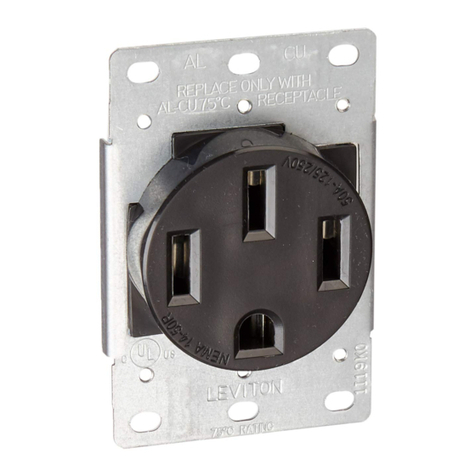
Leviton
Leviton 279 Series Installation
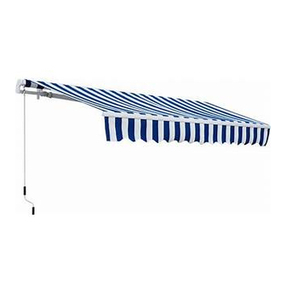
SunSetter
SunSetter 900XT Replacement

Stiga
Stiga King Size GT instruction manual

Hipcam
Hipcam HD008 user guide

Silent Call Communications
Silent Call Communications DB1-MC Installation and operating instructions
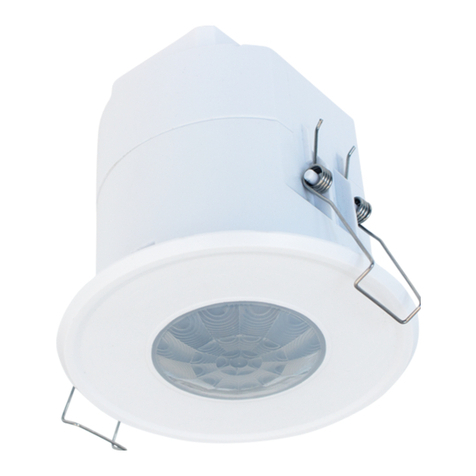
Hytronik
Hytronik HIR23/D2 Installation and instruction manual

